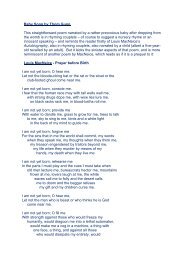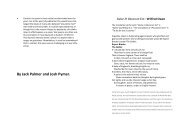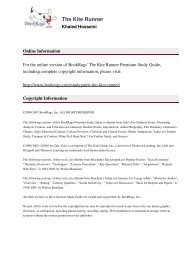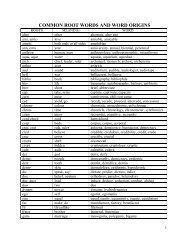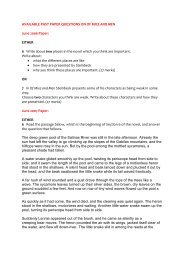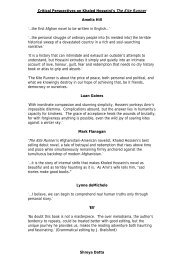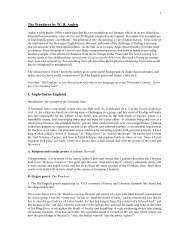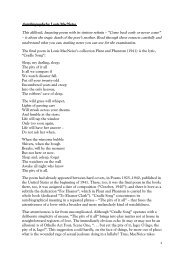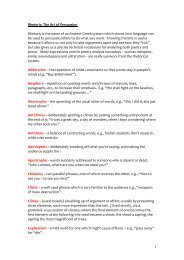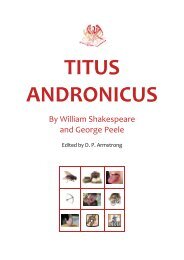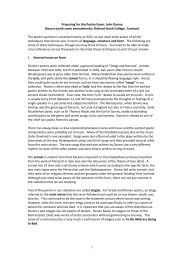John Clare - The Mouse's Nest, published 1935 ... - Hellesdon.org
John Clare - The Mouse's Nest, published 1935 ... - Hellesdon.org
John Clare - The Mouse's Nest, published 1935 ... - Hellesdon.org
Create successful ePaper yourself
Turn your PDF publications into a flip-book with our unique Google optimized e-Paper software.
<strong>John</strong> <strong>Clare</strong> - <strong>The</strong> <strong>Mouse's</strong> <strong>Nest</strong>, <strong>published</strong> <strong>1935</strong> (written 1832-7)<br />
You may remember <strong>Clare</strong>’s Sonnet from the AQA Anthology, and here is another one:<br />
naïve poetry, deceptively simple, in rhyming couplets.<br />
A simple respectful description, it seems, of the lowliest of nature except, perhaps, for the<br />
words "odd" and "grotesque". A contrast to the sometimes pompous, self-conscious,<br />
theorizing abstractions of other romantic poets.<br />
Keats observed of <strong>Clare</strong>'s early poetry that "description too much prevailed over<br />
sentiment".<br />
<strong>Clare</strong> replied of Keats: "...it is the case with other inhabitants of great citys he often<br />
described nature as she appeared to his fancys and not as he would have described had he<br />
witnessed the things he describes...what appear as beautys in the eyes of a pent up citizen<br />
are looked upon as conceits by those who live in the country."<br />
<strong>Clare</strong> is witness to the experienced details of landscape and its changes.<br />
[BBC]<br />
[Mouse’s <strong>Nest</strong>, the commonplace selection from a week ago] exemplifies what it is in<br />
[<strong>Clare</strong>] that I find endlessly fascinating. Here is <strong>Clare</strong> on his rounds again, telling us what<br />
he has just seen but neglecting to mention why he thinks it ought to interest us or even<br />
him. Though it has been likened to Burns, there is no suggestion implicit or otherwise<br />
that the sight of this “wee, sleekit, cowrin’, tim’rous beastie” has stirred <strong>Clare</strong> to<br />
reflections on his own unsatisfactory condition or that of mankind in general; there is not<br />
even a sign that <strong>Clare</strong>’s mouse is cowrin’ and tim’rous. <strong>Clare</strong> just happened by; before he<br />
recognized the creature as a mouse, he thought she looked odd and grotesque.<br />
Subsequently he saw no reason to revise his estimate and even less to humanize or<br />
allegorize her. Instead, after noting that she found her nest again, his attention turns, as<br />
the poem is signing off, to the undistinguished landscape. <strong>The</strong> water is having difficulty<br />
making its way over the pebbles. It must be a dry summer. <strong>The</strong> only hint of grandeur in<br />
the closure is the appearance of the cesspools – broad, old, glittering, they have their<br />
dignity under the sun, even though most travelers would hurriedly pass them by with<br />
pinched noses. And the poem is done. <strong>Clare</strong> was here – he saw what there was to see and<br />
noted it down, then went about the business of idle observation, ready to collect further<br />
swatches of nature as casually as one might pick a wildflower, press it between the pages<br />
of a book, and f<strong>org</strong>et it.<br />
[Geoff Klock]<br />
This looking around can find its reward in unexpected places–perhaps in the street as we<br />
walk; perhaps in a book that we are reading; perhaps in our reverie or dreams. We poke<br />
about. In the language of the English poet <strong>John</strong> <strong>Clare</strong>, we “prog.” His untitled poem set<br />
1
after haying time, now called “<strong>The</strong> Mouse’s <strong>Nest</strong>,” written sometime between 1832 and<br />
1837, portrays a moment of looking for nothing in particular, but looking, while<br />
wandering through the already mown fields, and finding something:<br />
I found a ball of grass among the hay<br />
And progged it as I passed and went away [progged = prodded]<br />
And when I looked I fancied something stirred<br />
And turned agen and hoped to catch the bird<br />
When out an old mouse bolted in the wheat<br />
With all her young ones hanging at her teats[.]<br />
She looked so odd and so grotesque to me<br />
I ran and wondered what the thing could be<br />
And pushed the knapweed bunches where I stood[.]<br />
When the mouse hurried from the crawling brood<br />
<strong>The</strong> young ones squeaked[,] and when I went away<br />
She found her nest again among the hay[.]<br />
<strong>The</strong> water oer the pebbles scarce could run<br />
And broad old cesspools glittered in the sun<br />
[According to the OED, “craking” would mean making a harsh cry; some editors have<br />
“squeaking” and others “crawling”; Again, the OED says that cesspools = a dug pit for<br />
catching sediment for a stream, or refuse from waste water.[<br />
He does not analyze what he finds, but follows his feeling into a new moment. His feeling<br />
does not need any comment. Whereas most of the time, as Dickinson writes, “‘Tis many<br />
a tiny Mill / Turns unperceived beneath our feet” (<strong>John</strong>son 1097; Franklin 1102), <strong>Clare</strong>’s<br />
tiny mouse has unfettered the whole world, in his spirit.<br />
Reading <strong>Clare</strong>’s poem, which was written amidst the drastic social change and suffering<br />
caused by the private appropriation of public lands and the resulting displacement and<br />
impoverishment of poor laborers, I cannot help feeling that in the utter otherness of the<br />
mouse, he saw himself. Like the mouse, he had many children to support by his physical<br />
labor, since he could not do so by his verses. And perhaps he felt he himself was<br />
considered “odd and grotesque.” Certainly he was pained in his awareness of being<br />
different from those among whom he lived–<strong>Clare</strong> was unlike other farm laborers in being<br />
a poet, and in being a farm laborer, he was very unlike other poets. Of all the little things<br />
he sees while meandering through the field in a thoughtful mood, it is the peculiar<br />
overburdened mouse which in some way he in particular is predisposed to notice.<br />
Noticing it–merely seeing it–he has accomplished the work that his imagination was ready<br />
to do, and this accomplishment makes him feel exalted. <strong>The</strong> world appears to him in a<br />
different way. He has been given, or rather he has given himself, an intensely awake<br />
moment simply because the vague and unconscious availability of his feeling, of his mind,<br />
has found that which it was available for–the symbol of his feeling, rather than the<br />
analysis of it or the naming of it.<br />
Since we writers begin in aftermath, we might look carefully over the mown field for<br />
whatever we may happen to notice, and we might listen for any echo of what was said<br />
when the field was filled with men and women and children laboring. We will see<br />
something, and hear something, even if what is there is mostly nothing and silence. We<br />
2
listen for what others heard, and also for what was not heard by anyone–what we<br />
ourselves did not hear, or once heard and then could no longer hear until in the<br />
aftermath we listened once more. And when suddenly we see our own mouse, and<br />
perceive it fully, we are taken by a feeling of exaltation because we gain access to another<br />
world inside the world. Even muddy rain puddles then glitter in the sun. <strong>Clare</strong>’s<br />
responsiveness to what he sees, this seeing of that to which he is responsive, this<br />
acknowledging of his own response, is who <strong>Clare</strong> is; and in finishing the poem, he has<br />
brought himself into the truth of his being.<br />
[Reginald Gibbons]<br />
<strong>John</strong> <strong>Clare</strong> was born at Helpstone, Northamptonshire in 1793, his father a farm-labourer<br />
and his mother the daughter of a local shepherd. He was therefore deep-rooted in a place<br />
and in a class by his parents, and was also affected by their 'trash of Ballad Singing . . . my<br />
first feelings and attempts at poetry were imitations of my father's songs . . .' He worked<br />
as a labourer, continually composing poems and in 1820 a selection of these was<br />
<strong>published</strong> by <strong>John</strong> Taylor (Keats's publisher), which had a great and fashionable success.<br />
Fashion changed, <strong>Clare</strong> continued to write, but further volumes failed. Disappointed,<br />
horrified by the cruel changes (enclosures) of the world he knew and loved, in 1837 he<br />
mentally broke down and was taken into a kindly private asylum in Epping Forest. Four<br />
years later he walked home from the place, eighty miles in three and a half days,<br />
subsisting on roadside grass. Later that year, 1841, he was certified insane and confined,<br />
again with much understanding, in the Northampton Asylum, where he remained,<br />
continuing to write, for twenty-three years until his death.<br />
He composed ballads, long narratives in verse, philosophical poems, 'imitations' of other<br />
poets,and in this selection an attempt is made to suggest that variety: his genius lay in his<br />
quick observation of the people and places and creatures (especially birds) he saw around<br />
him. Edmund Blunden remarked on <strong>Clare</strong>'s 'elemental terseness' and likened it to the<br />
nature-engravings of Bewick. <strong>Clare</strong> knew that accurate description is like turning down a<br />
page in a book to mark a favourite passage (which may be a bad habit but Coleridge used<br />
the butter-knife): 'How many pages of sweet nature's book/Has poetry doubled down as<br />
favourite things . . .' and thereby fixed the transient. His genius was for detail. His<br />
milkmaid turns her buckets upside down so that she and <strong>Clare</strong> can sit, then she milks her<br />
'breathing' cows - we see their steaming breath.<br />
His 'elemental terseness' can end a poem about a mouse's nest, suddenly, '<strong>The</strong> water o'er<br />
the pebbles scarce could run/And broad old cesspools glittered in the sun.' After the<br />
close-up the long-shot, placing the mouse (and <strong>Clare</strong>) in their world and season.<br />
3
[P. J. Kavanagh]<br />
<strong>Clare</strong>’s stubbornness in his adherence to the many registers of this<br />
single principle, the ethical refusal to exploit the objects of nature,<br />
whether by physical or aesthetic means, cut him off from the production<br />
of true poetic genius according to the dominant aesthetic theories of<br />
the day. But that is not to say that his poetic practice did not constitute<br />
an aesthetic position. He believed in a different poetic truth, in a strict<br />
adherence to truthfulness in the representation of nature and human<br />
activity in nature. Even when the poet entered the poem as a human<br />
figure, potentially the poem’s subject, <strong>Clare</strong> refused to redirect meaning<br />
into the poetic self. This resistance to recuperation is clear enough in<br />
another sonnet of around 1835, ‘<strong>The</strong> Mouse’s <strong>Nest</strong>’:<br />
I found a ball of grass among the hay<br />
And progged it as I passed and went away;<br />
And when I looked I fancied something stirred,<br />
And turned again and hoped to catch the bird—<br />
When out an old mouse bolted in the wheats<br />
With all her young ones hanging at her teats;<br />
She looked so odd and so grotesque to me,<br />
I ran and wondered what the thing could be,<br />
And pushed the knapweed bunches where I stood;<br />
<strong>The</strong>n the mouse hurried from the craking brood.<br />
<strong>The</strong> young ones squeaked, and as I went away<br />
She found her nest again among the hay.<br />
<strong>The</strong> water o’er the pebbles scarce could run<br />
And broad old cesspools glittered in the sun.<br />
<strong>The</strong> human figure in the poem gives us no clue about what this event<br />
might mean. We witness an instinctual response (the poet’s running)<br />
to an inexplicable sight. We cannot even guess at the cause of this<br />
response, much less construct a moral out of it. If this were an incident<br />
from ‘<strong>The</strong> Prelude’, the poet would meditate on the event and<br />
eventually secure its meaning, and the apparent panic attack would be<br />
superseded as a necessary negative stage in the growth of the poet’s<br />
mind. This final meaning would be at the expense of the quality of<br />
the moment, and <strong>Clare</strong> strives to preserve the truthfulness of that<br />
visceral moment’s inexplicability. <strong>The</strong> final couplet is a logical non<br />
sequitur; the glittering cesspool bears no relation to the mouse, yet it<br />
rings true as the next moment in <strong>Clare</strong>’s intense perception and scrupulously<br />
accurate representation of the world he viewed. In creating<br />
these intensely perceptual poems, <strong>Clare</strong> is unique as a sonnet writer.<br />
Rather than developing an argument through the length of an octave<br />
and sestet or three quatrains and a couplet, <strong>Clare</strong> creates a series of vivid perceptual<br />
moments of an almost cinematic quality. <strong>The</strong> matter of the poems is not formal, and thus<br />
the sonnet becomes merely the unit of perception.<br />
4
[From www.palgrave.com]<br />
5



